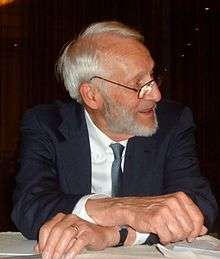John U. Bascom

John U. Bascom M.D., FACS, was an American surgeon and researcher who pioneered new understanding and treatment of pilonidal disease.
Early life
He was born June 6, 1925, in Richmond, Virginia, to Lillian and Dr. K.F. Bascom. His father was an anatomist and teacher at the Medical College of Virginia.[1] John graduated from the U.S. Merchant Marine Academy at Kings Point, N.Y., and served in the Pacific from 1943 until the masters, mates and pilots strike of Oct. 1, 1946.[2]
Education
He earned a bachelor's in physics and master's degree in biological science from Kansas State University, graduated from Northwestern University School of Medicine on June 15, 1953 and interned at Cook County Hospital in Chicago, before starting a surgical fellowship at Minneapolis General Hospital. He earned a PhD in surgery from the University of Minnesota in 1960, where he researched topics in vascular surgery, including vascular graft materials, with Dr. C.R. Hitchcock.[3]
Career
He moved to Oregon in 1960 and worked in Eugene, where he did much of his important research into pilonidal disease, a condition more popularly known as "Jeep seat." The condition had long been attributed to congenital pits in the skin, ingrown hairs or trauma from repeated pressure over the tailbone (such as riding long periods on bumpy terrain in a Jeep). Bascom researched and proposed an alternate theory that normal hair follicles grew infected and swelled shut, with the infection then tracking down into soft fat below the skin and creating abscesses.[4] He also helped adapt and refine less-invasive surgeries for treating persistent pilonidal disease.[5] This work was praised as "lucid" and a "paradigm shift" by some fellow surgeons.[6] He also published articles on topics including hernias and saline overload, and belonged to professional groups including the Oregon Board of Medical Examiners, which he chaired.[7]
Personal life
Bascom met his wife, Ruth - who became the first female mayor of Eugene, Oregon - in sixth grade in Manhattan, Kansas.[8] The two married 13 years later and had four daughters and two sons, all of whom went into medicine (four became doctors, one a nurse and one a pharmacist). He was an avid cyclist, often biking to work, and broke his hip in a bicycle accident at age 87. He broke his other hip in a fall the next year and died from complications on March 22, 2013.[9]
References
- ↑ Bascom, KF; Osterud HL (November 1927). "Quantitative studies of the testis III. A numerical treatment of the development of the pig testis". The Anatomical Record. 37 (1): 63–82. doi:10.1002/ar.1090370105. Retrieved 24 March 2013.
- ↑ "New Wage Policy Asked by Union In Ship Strike". The Cornell Daily Sun. October 23, 1946. Retrieved 24 March 2013.
- ↑ Hitchcock, CR; Johnson FE; Bascom JU; Murphy TO (February 1959). "Comparative results of various types of grafts and shunts in the treatment of occlusive peripheral vascular disease.". Angiology. 10 (1): 11–19. doi:10.1177/000331975901000102. PMID 13627555.
- ↑ Bascom, John (May 1980). "Pilonidal disease: Origin from follicles of hairs and results of follicle removal as treatment". Surgery. 87 (5): 567–572. PMID 7368107.
- ↑ Bascom, John; Bascom T (October 2002). "Failed Pilonidal Surgery: New paradigm and new operation leading to cures". Archives of Surgery. 137 (10): 1146–1150. doi:10.1001/archsurg.137.10.1146. PMID 12361421.
- ↑ Kingsnorth, AN (June 1994). "Invited Comment on Pilonidal Disease". Current Practice in Surgery: 181.
- ↑ Federation of State Medical Boards (June 1977). Federation Bulletin (PDF). 64 (6): 187 http://mss.fsmb.org/FSMBJournal/V64/June77.pdf. Missing or empty
|title=(help) - ↑ Baker, Mark (February 12, 2007). "Resolute Ruth Bascom bikes on". The Register-Guard. Retrieved 24 March 2013.
- ↑ "Obituary of Dr. John Bascom". Eugene Register-Guard. Retrieved 3 December 2013.